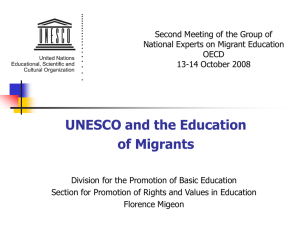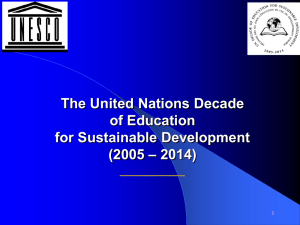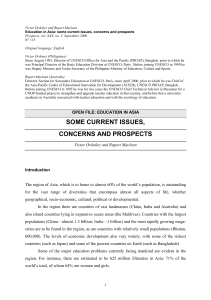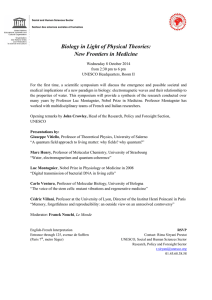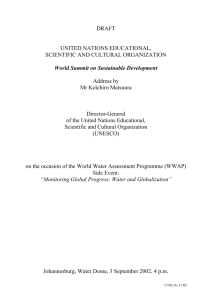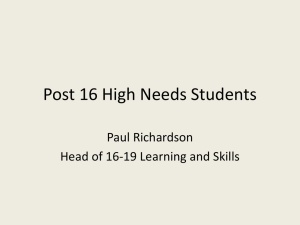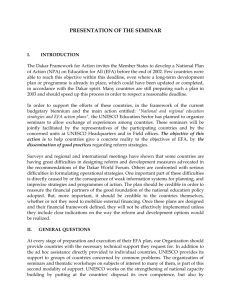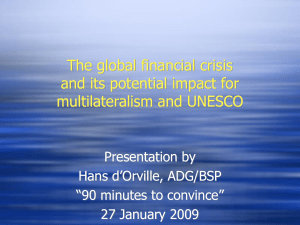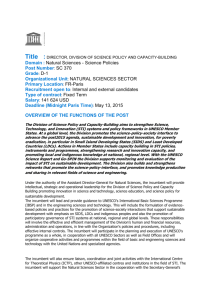UNESCO`s understanding of education quality
advertisement
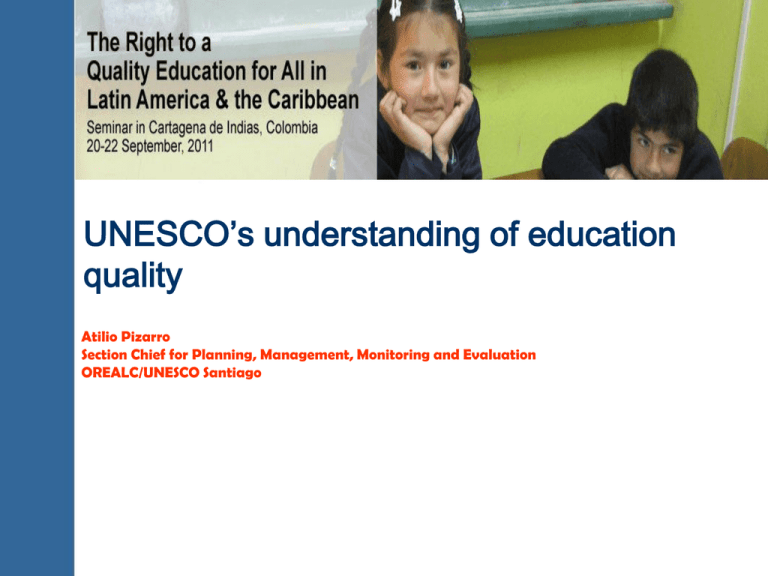
UNESCO’s understanding of education quality Atilio Pizarro Section Chief for Planning, Management, Monitoring and Evaluation OREALC/UNESCO Santiago International Commitments on Education EFA Dakar Goals 1. Expanding early childhood care and education 2. Free and compulsory primary education for all 3. Learning & life skills for young people and adults 4. Increase adult literacy 5. Eliminating gender disparities and achieving gender equality 6. Improving all aspects of the quality of education Millennium Development Goals 2. Achieve universal primary education 3. Promote gender equality and empower women 2015 Assessing progress towards EFA Goals in Latin America and the Caribbean UPE is no longer a challenge with overall 95% enrolment (UIS, 2008) Access to pre-primary level (ECCE), as well as access and completion of secondary education & TVET, are serious concerns. Half of the youth population (20 to 24 years) have not completed secondary education, the threshold for being out of poverty. Need to improve quality of education at all levels. The great social inequality in Latin America and the Caribbean is a problem that education has not yet been able to solve. EFA Goal 6 Remains a Challenge Undeniable progress toward expanding access to education It has not been met by comparable progress in improving education quality, which affect, to a large extent, the most vulnerable individuals and groups. This is a permanent challenge in the region that shall continue beyond 2015 UNESCO Must Ensure that Education for All (EFA) remains a priority on the global agenda, Support countries’ efforts to meet the six EFA goals by 2015, with a specific emphasis on equity. Act beyond this: Sustainable development Inclusion, Social cohesion and social justice, Life-long learning Higher education and research. Why focus on Quality? Need to increase the effectiveness of education and training systems. Need to reduce the observed inequalities among various categories of the population. Growing diversity and complexity of societies: Migration, Urbanization, Cultural globalization, and Greater access to expanding sources and channels of transmission of information, knowledge and values. Quality education An effective means to fight poverty, Empowers individuals, Prepares people to embrace and adapt to change but also to manage and influence it, Build democracies, and foster peaceful societies, A human right and public good Is an indispensable element for achieving sustainable development Long life learning UNESCO’s understanding of education quality Learning: The Treasure Within, Report to UNESCO of the International Commission on Education for the Twenty-first Century, Jacques Delors (1996): Learning to know Learning to do Learning to live together Learning to be Quality – the purpose of Education Two 2 key elements : To ensure the cognitive development of learners In nurturing the creative and emotional growth of learners and in helping them to acquire values and attitudes for responsible citizenship What Do We Mean by Education Quality? Frequent approach: quality is equal to the efficiency and effectiveness Multidimensional concept Implies a value judgment A dynamic concept that changes and evolves with time and changes ______ 10 New times, new demands in LAC The countries of the region are living large social and political changes: new paradigms and models of development, new constitutional frameworks and reforms to the education laws. Constitutional and legal mandates pose profound challenges to education systems. A rights-based approach: a paradigm shift; EFA/PRELAC (UNESCO, 2002) • . To go from an emphasis on inputs and structures to one on people To go from mere transmission of content and understanding to comprehensive development of human beings. To go from homogeneity to diversity To go from focus placed on schools alone as venues for education to ‘educating society’ UNESCO’s holistic and rights-based approach Education is a public good and a human right from which nobody can be excluded Calls for inclusive quality education A particular focus on vulnerable and marginalized groups. Schooling be free and obligatory Rights of non-discrimination and full participation. Assure equity in three dimensions: in access, in process, and in results. Quality Education for All: a human rights issue OREALC / UNESCO Santiago (2007), www.unesco.cl Under the rights framework base for quality of education, it has been identified three substantive aspects: Relevance Pertinence Equity Also, since being a public action matter, it is included two key operational aspects under the rights approach: Efficacy Efficiency What Do We Mean by Education Quality? A broad concept of quality education: Pertinence Relevance Quality Education Efficacy •Diversity and flexibility • Curriculum • Regulation • Classroom practices/assessment analysis Rights, 4 pillars, meanings • Curriculum • Regulation • Practices/assessment Objective achievement, curriculum management • Access • Completion • Students academic achievement • Teachers (who are they, conditions, practices) • Climate Efficiency Finance, resources management, social responsibility • Management, participation • Availability/use of resources Equity Inclusion, equal opportunities, resources • Achievement parity (efficacy) • Tendencies • Alternative education/positive discrimination Beyond 2015 – Where do we go from here? Rethinking quality of education: how do the various aspects of quality relate to each other? Pedagogical methods, assessment of and for learning, 21st century skills, etc. Education convergence in LAC Creating a suite of education quality indicators Need to asses and understand the impact of education in mitigating inequity Teachers are key ______ Thank you ______

